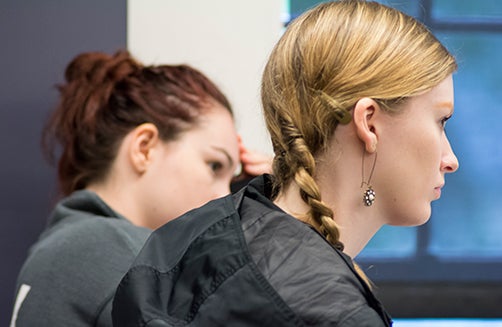Bachelor of Arts in History
Learning Outcomes

The University of Rhode Island undergraduate program
in history is taught in three different formats:
- 100-level courses
- 300-level courses
- 400-level courses.
Primarily for freshmen and sophomores, 100-level courses serve students university-wide who are seeking credits for general education requirements, as well as potential history majors.
Primarily for juniors and seniors, 300-level courses offer more detailed information and historical concepts in particular subjects. The 300-level courses are completed by students earning a B.A. in history, but can also be part of other disciplinary programs including Film Media, International Studies and Diplomacy, Gender & Women’s Studies, and Africana Studies.
The capstone sequence, taught at the 400 level, is for history majors and history/secondary education double majors who are typically in their junior or senior years.
These learning objectives have been designed with all of the above students in mind and on the assumption that general education students, majors in other disciplines, and history and education degree candidates will benefit from learning how to think critically, write effectively, and communicate as historians.
Students in history courses will begin to develop at the 100 level and then perfect at the 300 and 400 level their “historical understanding.” This includes –
- Periodization: how change occurs over time and how events create historical causation.
- Geography: how societies are influenced by their geographical location, natural resources, and physical relationship to other parts of the world
- Ideas: how philosophical, political, scientific and religious ideas have influenced the past.
- Diversity: how race, gender, class, ethnicity, and religion create “histories” rather than a monolithic past.
- Factual: how people, places, spatial relationships, and events create historical change.
Students will develop the following skills as they progress toward graduation:
- understand the distinction between primary and secondary sources
- read primary and secondary sources in a critical way
- compare and contrast historical interpretations (historiography)
- construct and communicate historical arguments, primarily in written form
- demonstrate factual understanding
- demonstrate conceptual understanding
In 100- and 300-level history classes:
Students will improve their mastery of the following abilities in oral presentations, papers, exams and group assignments: Students will –
- question the limits of the sources’ framing of historical questions
- identify biases of the authors of sources.
- write clear well-formed sentences and paragraphs
- analyze primary and/or secondary sources
- frame and answer historical questions
- analyze the context in which the sources were created
- extract information relevant to the assignment
- quote the sources accurately and effectively
- follow scholarly conventions in citations as appropriate
In the 400-level history sequence:
Students will study historians’ accounts of a thematic topic, locate primary sources, prepare a research paper précis, and prepare two drafts of a research paper/project. As a result, students will-
- identify and establish a meaningful historical question
- demonstrate knowledge of historical context
- find, interpret, and use primary sources appropriately
- demonstrate knowledge of historiography
- construct an effective argument in support of a thesis
- write effectively using standards for a historian
- cite and document sources appropriately
Level of Student Performance:
At graduation, over 75% of history majors meet or exceed learning objective mastery in the 400 level sequence.
The following methods may be used to assess student progress at all levels:
- Small group discussion of primary documents and/or secondary sources
- Examinations, including essay and objective test formats
- Paper assignments that incorporate elements of “historical understanding” (see above).
- Pre-course and post-course student surveys
- IDEAs that include discipline-specific questions
- Portfolio collection of précis and research papers produced in the 400 level capstone sequence in the History department
Department governance of assessment and outreach to students includes:
- Learning objectives included in course syllabi
- Collection in History department of course syllabi and sample assignments
- Dissemination of goals/assessment guidelines to part-time, and new faculty
- Faculty self-assessment
- Periodic review of guidelines and syllabi by a department assessment committee
- Annual department programatic evaluations

